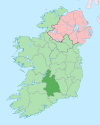Iffa and Offa West
Iffa and Offa West (
Legal context
Baronies were created after the
History
As the name suggests, in medieval times the territory of the barony (and its neighbour to the east) was controlled by the Gaelic clans of Uíbh Eoghain and Uíbh Fhathaidh. Following the conquest of Ireland by the Normans, much of the territory was, by royal grant, handed over to the victorious barons.
Feudal history

Cahir Abbey was in existence by c.1200 when the prior is listed as a witness to one of the documents contained in the register of the hospital of St. John's Dublin. In this, a grant to the hospital by Geoffrey de Camville, the prior John is described as first prior (Primo – Priore) of "Kaherdunesche", which suggests that the priory was a relatively recent foundation at this time. It is the same Geoffrey de Camville who is credited with the foundation of the priory in Cahir. Geoffrey was Baron of both Cahir and Fedamore in Co. Limerick.[2]
Having no male heir (the only child of Geoffrey and Felicia being a daughter, Felicia de Camville), the titles to the baronies lapsed.[
The next time that a "
Modern times
When County Tipperary was split into North and South Ridings in 1836, Iffa and Offa West was allocated to the south riding. However, the neighbouring barony of Kilnamanagh was split into Upper and Lower half-baronies, being allocated to the north and south ridings respectively.[3]
Features
The barony is set in that part of the
Towns, villages and townlands of the barony
Ballylooby, Ballyporeen, Burncourt, Clogheen, Grange, Husseystown
Civil parishes of the barony
This table
| Name in Irish | Name in English |
|---|---|
| Ard Fhíonáin | Ardfinnan |
| Baile an Mhoirtéalaigh | Mortlestown |
| Baile an Róistigh | Rochestown |
| Baile Uí Bhéacáin | Ballybacon |
| An Caisleán Nua | Newcastle |
| An Chathair | Cahir |
| Deargráth | Derrygrath |
| Maigh Locha | Molough |
| An Neadán | Neddans |
| Seanraithin | Shanrahan |
| An Teampall Geal | Whitechurch |
| Teampall Toinne | Templetenny |
| Tiobraid | Tubbrid |
| Tulach Artáin | Tullaghorton |
| Tulaigh Mhaoláin | Tullaghmelan |
See also
- List of civil parishes of South Tipperary
References
- ^ http://www.geneajourney.com/camvil.html Geoffrey de Camvillle history
- ^ https://dirl.com/tipperary/cahir/cahir-abbey.htm Cahir Abbey history
- ISBN 0-946327-14-9.
- ^ Database of Ireland – civil parishes.
External links
- Walsh, Dennis (2003). "Barony Map of Ireland". Retrieved 13 February 2007. Source given is "Ordnance survey".


